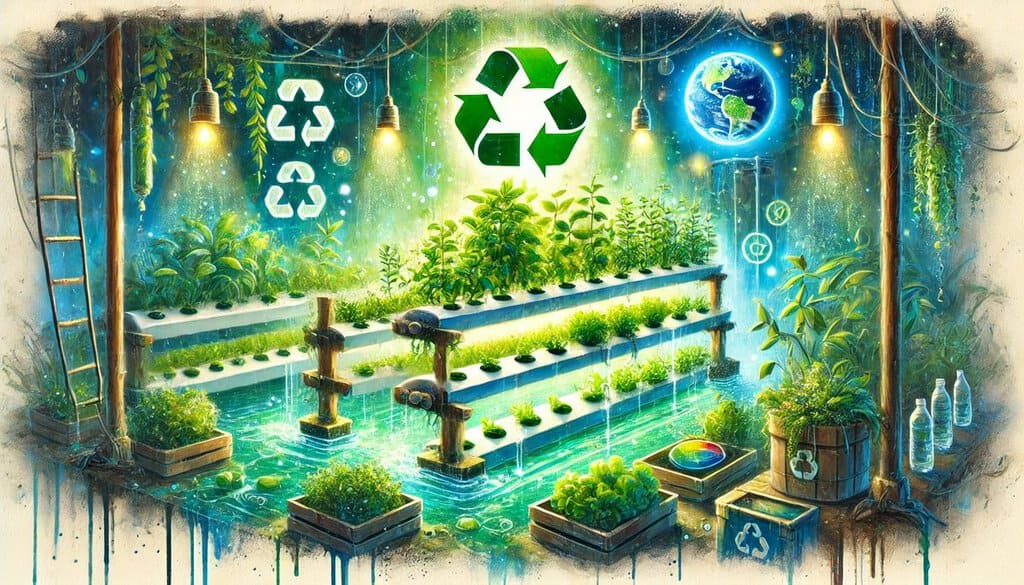Hydroponics, an innovative agricultural technique, has significant impacts on the environment, both positive and negative. Let’s explore the various ways hydroponics affects our ecosystem:
Water Conservation
Hydroponics offers substantial benefits in terms of water conservation. Compared to conventional farming methods, hydroponic systems consistently demonstrate lower environmental impacts related to freshwater consumption[1]. This is primarily due to the closed-loop nature of hydroponic systems, which allow for efficient water recycling and reduced evaporation.
However, whenever used nutrient solutions are discarded into wastewater and streams, there are still a lot of nutrients left, which creates algae blooms and other problems; therefore, it is important to discard used nutrient solutions in an environmentally responsible way, or better yet, only add the missing nutrients and re-use the solution. However, this can be very hard to do, especially for a hobbyist without the proper testing equipment.
Land Use Efficiency
One of the most significant advantages of hydroponics is its ability to maximize land use efficiency:
- Vertical Stacking: By utilizing vertical farming techniques, hydroponics enables the cultivation of crops in stacked layers, dramatically reducing the land footprint required for food production[2].
- Urban Integration: Hydroponic systems can be implemented in urban areas, shortening the food supply chain and reducing transportation emissions[2].
Resource Optimization
Hydroponics optimizes the use of various resources:
- Fertilizers: The controlled environment of hydroponic systems allows for precise nutrient management, potentially reducing fertilizer runoff and associated environmental issues[1].
- Pesticides: Indoor hydroponic setups can minimize the need for pesticides, reducing their environmental impact.
Energy Consumption
While hydroponics offers many environmental benefits, it’s important to note that energy consumption can be a significant concern:
- Lighting: In vertical farming applications, the energy required for artificial lighting is a major contributor to environmental impacts[5] and cost.
- Climate Control: Maintaining optimal growing conditions in indoor hydroponic systems may require substantial energy for heating, cooling, and humidity control.
Environmental Impact Reduction
Studies have shown that hydroponics, particularly when using reclaimed water, can lead to lower environmental impacts across various indicators:
- Climate Change: Hydroponic systems using reclaimed water have been found to produce 131 kg CO2 eq. less than conventional water systems[1].
- Air Quality: These systems also show reduced fine particulate matter formation (0.108 kg PM2.5 eq. less)[1].
Challenges and Considerations
Despite its potential, hydroponics faces some environmental challenges:
- Initial Investment: High setup costs can be a barrier to widespread adoption[2].
- Material Use: The use of materials like PVC in hydroponic systems can contribute to environmental burdens[1].
- Crop Suitability: Not all crops are equally suited for hydroponic cultivation. For example, wheat production in vertical hydroponic systems has been found to be less environmentally sustainable than conventional farming due to its low photosynthetic conversion efficiency and high energy requirements[5].
In conclusion, while hydroponics offers promising solutions to many environmental challenges in agriculture, its overall impact depends on factors such as energy sources, system design, and crop selection. As technology advances and renewable energy becomes more prevalent, the environmental benefits of hydroponics are likely to increase, potentially playing a crucial role in promoting sustainable agriculture and addressing food security challenges.
External sources:
[1] https://www.semanticscholar.org/paper/f7de6e5ec85dd3a741b5dfd4d20ae9f511943945
[2] https://www.semanticscholar.org/paper/5f889d8065244ba89ebc42072b010afce2a035d6
[3] https://www.semanticscholar.org/paper/9bc38260de48820d4c4016c6e59e391ea42c0a3b
[4] https://www.semanticscholar.org/paper/51ba5ff847979d626614778bc2ff32d39000e51e
[5] https://www.semanticscholar.org/paper/b7def63b70be78d9d2a70851cfa61d28f8e55338

